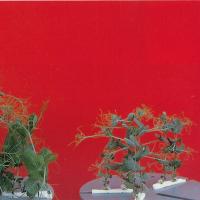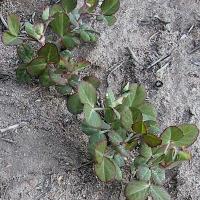Diagnosing phosphorus deficiency in field peas
Nearly all soils in Western Australia were phosphorus (P) deficient when cleared for agriculture, but continual use of P fertiliser means acute deficiency in broadacre crops is rare, with the exception of very acidic and high PBI (phosphorus buffering index) soils, P deficiency is often transitory and compounded by dry soil with symptoms disappearing when topsoil is re-wet following rainfall.
What to look for
- Smaller darker plants with worse symptoms on higher P-fixing, water repellent and very acidic soils, and in very dry seasons.
Paddock
- Reduced early growth, stunting, and darkening in colour of the whole plant. Reddening of stems, petioles, tendrils and leaf margins can occur, particularly if the plant is stressed.
- Older growth is first and most affected.
- As deficiency progresses, older leaves develop mottled chlorosis, and leaf margins become severely chlorotic then die.
Plant
What else could it be
| Condition | Similarities | Differences |
|---|---|---|
| Diagnosing autumn winter drought in cereals | Small darkened and reddened plants | Symptoms disappear when soil rewets. |
| Diagnosing hostile clay loam to clay subsoil | Smaller plants | Symptoms worse in dry conditions |
Where does it occur?
- P deficiency is more likely on high PBI soil.
- Dry topsoil can lead to temporary P deficiency on all soils particularly during early crop growth and on water repellent soils.
Management strategies
- Plants have a high P requirement for phosphorus during early growth and a deficiency can not be corrected within the growing season.
- Field pea sometimes show larger responses than wheat to P fertiliser applications, but this is not universal and on some soils (often those with a higher pH and lower nitrogen content) field pea has used P fertiliser more effectively than wheat.
- For peas, the wheat P calculator is a reasonable tool for estimating P requirement if making adjustments for pea yield and price.
- P is best applied at planting in a band to the side of or 2 to 3cm below, the seed. Placing fertiliser away from the seed prevents acid scorching. Nutrient release from deeper placement coincides well with root development.
How can it be monitored?

Soil test

Tissue test
- Soil test to determine P fertiliser requirements. Soil tests may underestimate available P on very low PBI sands and overestimate it on acidic and water repellent soils (particularly in the Darling Range).
- Use whole-top plant test to diagnose suspected P deficiency, and compare paired good/poor plant samples of the same age where possible.
See also
Further information
Where to go for expert help
Page last updated: Wednesday, 13 May 2015 - 4:11pm





